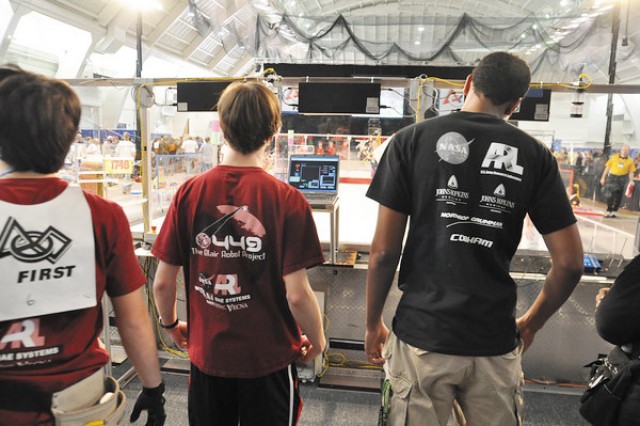U.S. Army Research Laboratory volunteers are helping to give a number of high school students the opportunity to work with robotics technology and may help them get college scholarships in preparation for careers in science and engineering.
ARL currently sponsors five teams of high school students who participate in the FIRST (For Inspiration and Recognition of Science and Technology) Robotics Competition, a not-for-profit program established to inspire young people's interest and participation in science and technology.
FIRST stages competitive games played by remote-controlled robots. The robots are designed and built during a six-week period from a common set of basic parts by teams of high school students and engineer-mentors who volunteer their time to work with the students.
Each school year, teams are formed in the fall and sports-like competitions take place in March and April. Referees oversee the competition and judges present awards to teams for design, technology, sportsmanship, community service and commitment to FIRST. Regional competitions lead to an annual international championship event at the Georgia Dome in Atlanta, Ga. FIRST also works with universities and companies to establish scholarship programs for the participants.
FIRST began in 1989 with 28 teams. It has almost 1,700 teams today.
ARL has been participating as a sponsor for the FIRST Robotics Competition for the past five years as part of the laboratory's Outreach Program, according to Leonard Huskey, associate director for Corporate Programs. Currently, ARL sponsors teams from Aberdeen High School, Eleanor Roosevelt High School in Greenbelt, Montgomery Blair High School in Silver Spring, Dundalk High School in Baltimore and Menchville High School in Newport News, Va., and there may be more teams in the future, Huskey said. However, none of the teams would be possible without the services of the mentors who volunteer large amounts of their time to work with the student teams.
"We have good people who care about students and getting more of them into science and engineering," Huskey pointed out.
Matt Wilbur, Mechanics Division, Vehicle Technology Directorate, served as a mentor for a FIRST Robotics Competition team in Hampton, Va., for a year, then started a team at Menchville High School. Also mentoring the team are co-workers Yolanda Hinton and Chester Langston.
"I do this because I believe that FIRST has developed the best way to get kids interested in science and technology. If you turn engineering and creative thinking into a sports event, the students become engaged very quickly," Wilbur explained.
Drew Wilkerson, Unmanned Vehicle Technologies Division, has been working with the FIRST program for about five years and mentors a team at the Science and Math Academy at Aberdeen High School. That team also sponsors the Halls Cross Elementary School FIRST Lego League, and there are plans to establish another team at Aberdeen Middle School in 2010.
Other ARL mentors include Mike Zoltoski, Weapons and Materials Research Directorate, and fellow VTD workers Harris Edge, Jim Spangler and Chad Kessens. Others involved with the programs include Miles Pekala, Dr. Mary Anne Fields, Raymond Von Whalde and Gary Haas.
"I feel this is one of the most valuable things I've ever done within the Army Outreach Program," Wilkerson said. He pointed out that his team has now started mentoring other teams giving the students a sense of self worth. "As they give freely of there time as mentors to the FIRST teams, they see the value of their contributions to their community through selfless service. This is a core Army value."
David Baran, Computational and Information Sciences Directorate, has been mentoring a team at Dunbar High School in Baltimore, for the past three years.
"My involvement started from a summer program at ARL where several of the students from Dunbar were brought into the lab for four weeks in order to gain some real-world work experience and get a better understanding of what is involved in being an engineer," he said.
Baran said he volunteers for the program because he feels it's a good way to get students engaged in science and technology.
"I can see the impact it has on the students as they sharpen not only their science and math skills, but also their decision making and time management abilities," he added.
The program is demanding of the mentors, but it is also demanding of the students. The mentors make it clear to the student team members from the beginning that they will be expected to work long hours during the robot build season while still maintaining all of their school work.
However, the mentors agreed that the program is a rewarding experience for the students because students gain the benefit of the mentors' time, experience and expertise as well as the opportunity for scholarship aid for college. In addition, some get actual work experience at ARL through the Science and Engineering Apprentice Program. Wilkerson said that mentors also benefit greatly from the experience.
"As in any good relationship, I feel I get far more out of it than the students do," Wilkerson said.
Wilbur commented on how satisfying it is to volunteer and experience the 'ah-ha' moments with the students.
"Many marvel at the hours that the mentors put in but you almost need to experience it to understand. Designing and building the robots is great fun, and the mentors get a rare opportunity to re-discover engineering through the eyes of the students. It's really neat when a concept sinks in and a student's eyes light up because they finally understand. It's a great way for them to build self-confidence as they begin to understand things that they thought were unreachable for them."


Social Sharing